Legal and Ethical Responsibilities of Nursing
VerifiedAdded on 2022/09/16
|14
|3645
|26
AI Summary
Contribute Materials
Your contribution can guide someone’s learning journey. Share your
documents today.
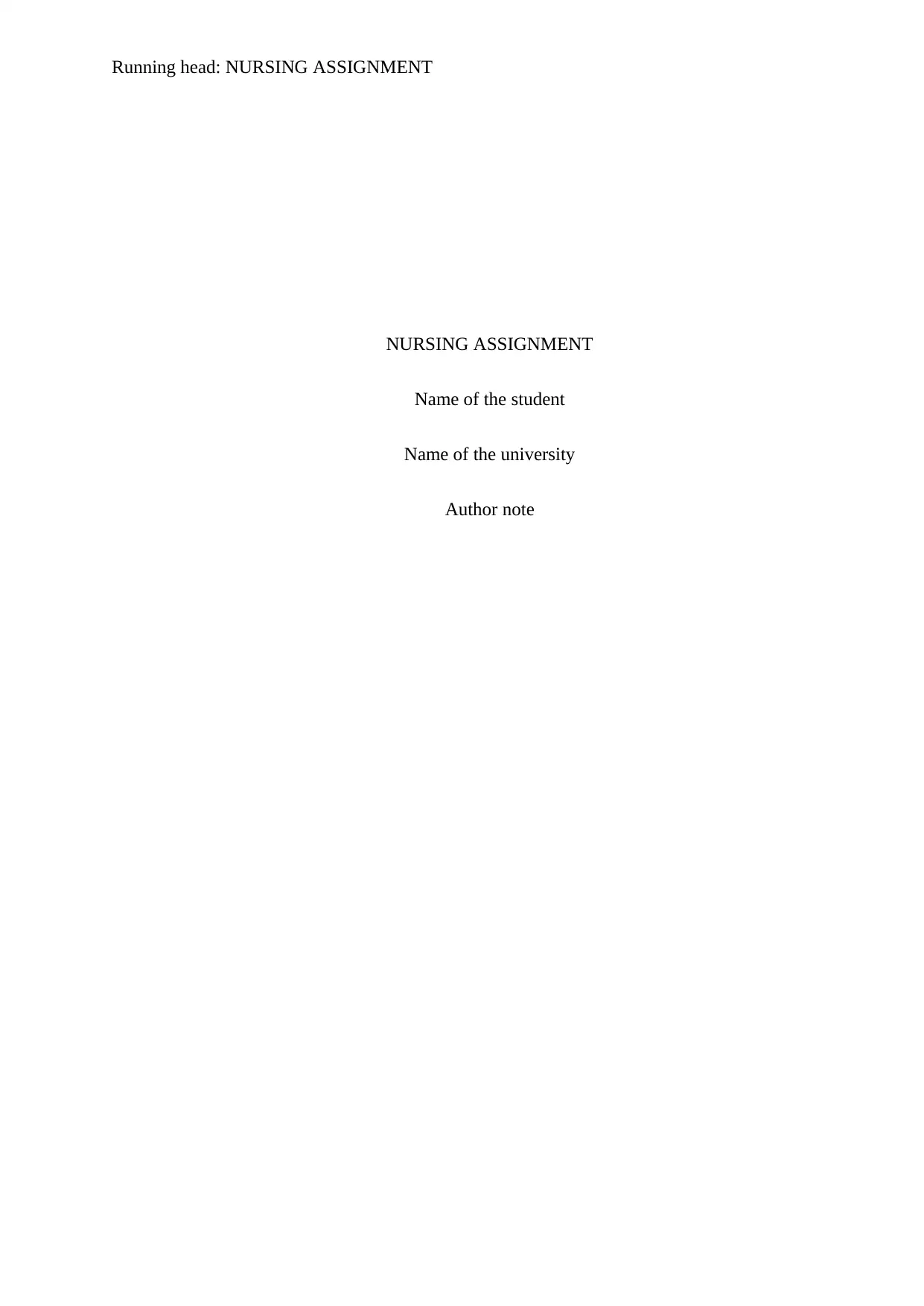
Running head: NURSING ASSIGNMENT
NURSING ASSIGNMENT
Name of the student
Name of the university
Author note
NURSING ASSIGNMENT
Name of the student
Name of the university
Author note
Secure Best Marks with AI Grader
Need help grading? Try our AI Grader for instant feedback on your assignments.
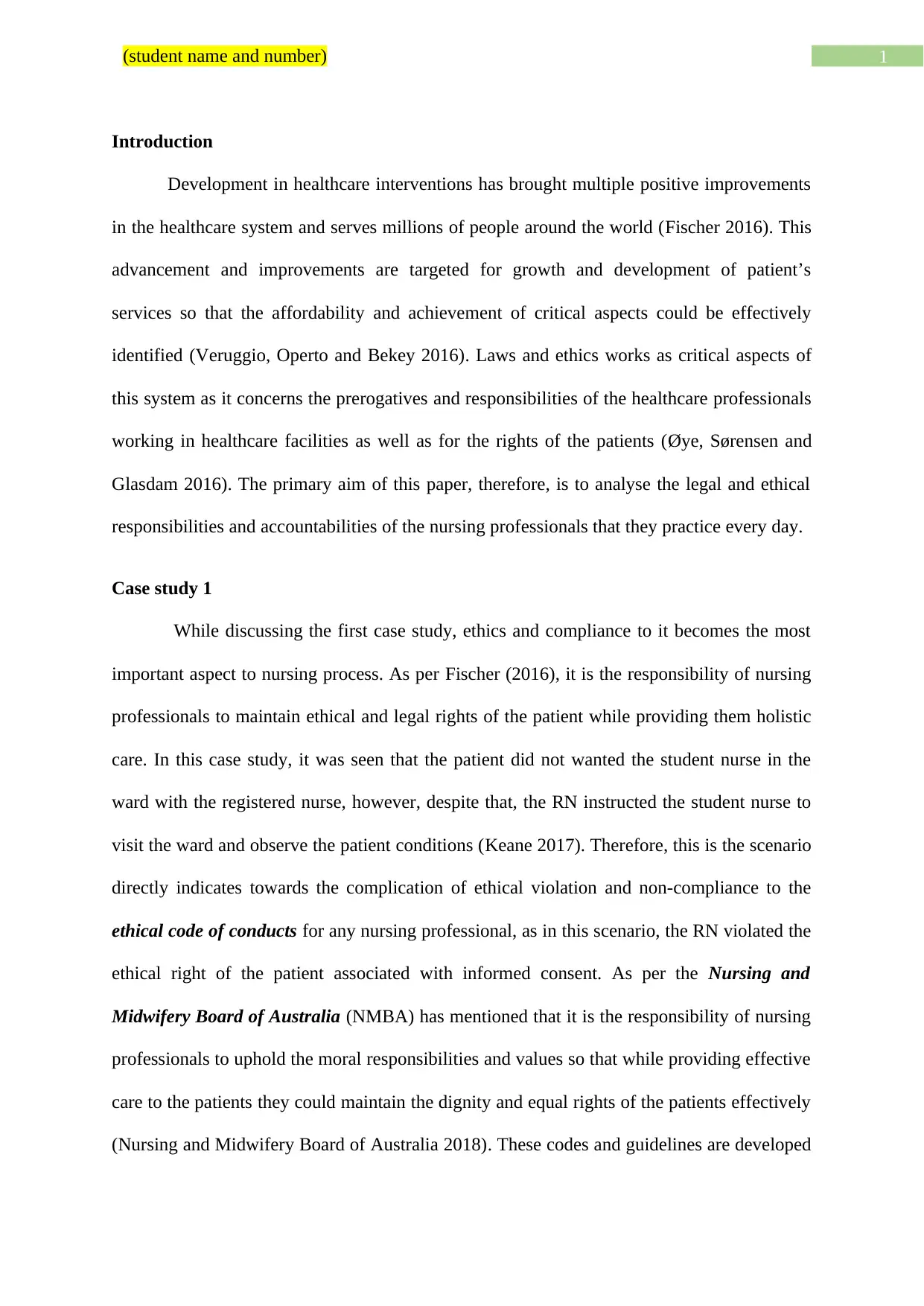
1(student name and number)
Introduction
Development in healthcare interventions has brought multiple positive improvements
in the healthcare system and serves millions of people around the world (Fischer 2016). This
advancement and improvements are targeted for growth and development of patient’s
services so that the affordability and achievement of critical aspects could be effectively
identified (Veruggio, Operto and Bekey 2016). Laws and ethics works as critical aspects of
this system as it concerns the prerogatives and responsibilities of the healthcare professionals
working in healthcare facilities as well as for the rights of the patients (Øye, Sørensen and
Glasdam 2016). The primary aim of this paper, therefore, is to analyse the legal and ethical
responsibilities and accountabilities of the nursing professionals that they practice every day.
Case study 1
While discussing the first case study, ethics and compliance to it becomes the most
important aspect to nursing process. As per Fischer (2016), it is the responsibility of nursing
professionals to maintain ethical and legal rights of the patient while providing them holistic
care. In this case study, it was seen that the patient did not wanted the student nurse in the
ward with the registered nurse, however, despite that, the RN instructed the student nurse to
visit the ward and observe the patient conditions (Keane 2017). Therefore, this is the scenario
directly indicates towards the complication of ethical violation and non-compliance to the
ethical code of conducts for any nursing professional, as in this scenario, the RN violated the
ethical right of the patient associated with informed consent. As per the Nursing and
Midwifery Board of Australia (NMBA) has mentioned that it is the responsibility of nursing
professionals to uphold the moral responsibilities and values so that while providing effective
care to the patients they could maintain the dignity and equal rights of the patients effectively
(Nursing and Midwifery Board of Australia 2018). These codes and guidelines are developed
Introduction
Development in healthcare interventions has brought multiple positive improvements
in the healthcare system and serves millions of people around the world (Fischer 2016). This
advancement and improvements are targeted for growth and development of patient’s
services so that the affordability and achievement of critical aspects could be effectively
identified (Veruggio, Operto and Bekey 2016). Laws and ethics works as critical aspects of
this system as it concerns the prerogatives and responsibilities of the healthcare professionals
working in healthcare facilities as well as for the rights of the patients (Øye, Sørensen and
Glasdam 2016). The primary aim of this paper, therefore, is to analyse the legal and ethical
responsibilities and accountabilities of the nursing professionals that they practice every day.
Case study 1
While discussing the first case study, ethics and compliance to it becomes the most
important aspect to nursing process. As per Fischer (2016), it is the responsibility of nursing
professionals to maintain ethical and legal rights of the patient while providing them holistic
care. In this case study, it was seen that the patient did not wanted the student nurse in the
ward with the registered nurse, however, despite that, the RN instructed the student nurse to
visit the ward and observe the patient conditions (Keane 2017). Therefore, this is the scenario
directly indicates towards the complication of ethical violation and non-compliance to the
ethical code of conducts for any nursing professional, as in this scenario, the RN violated the
ethical right of the patient associated with informed consent. As per the Nursing and
Midwifery Board of Australia (NMBA) has mentioned that it is the responsibility of nursing
professionals to uphold the moral responsibilities and values so that while providing effective
care to the patients they could maintain the dignity and equal rights of the patients effectively
(Nursing and Midwifery Board of Australia 2018). These codes and guidelines are developed
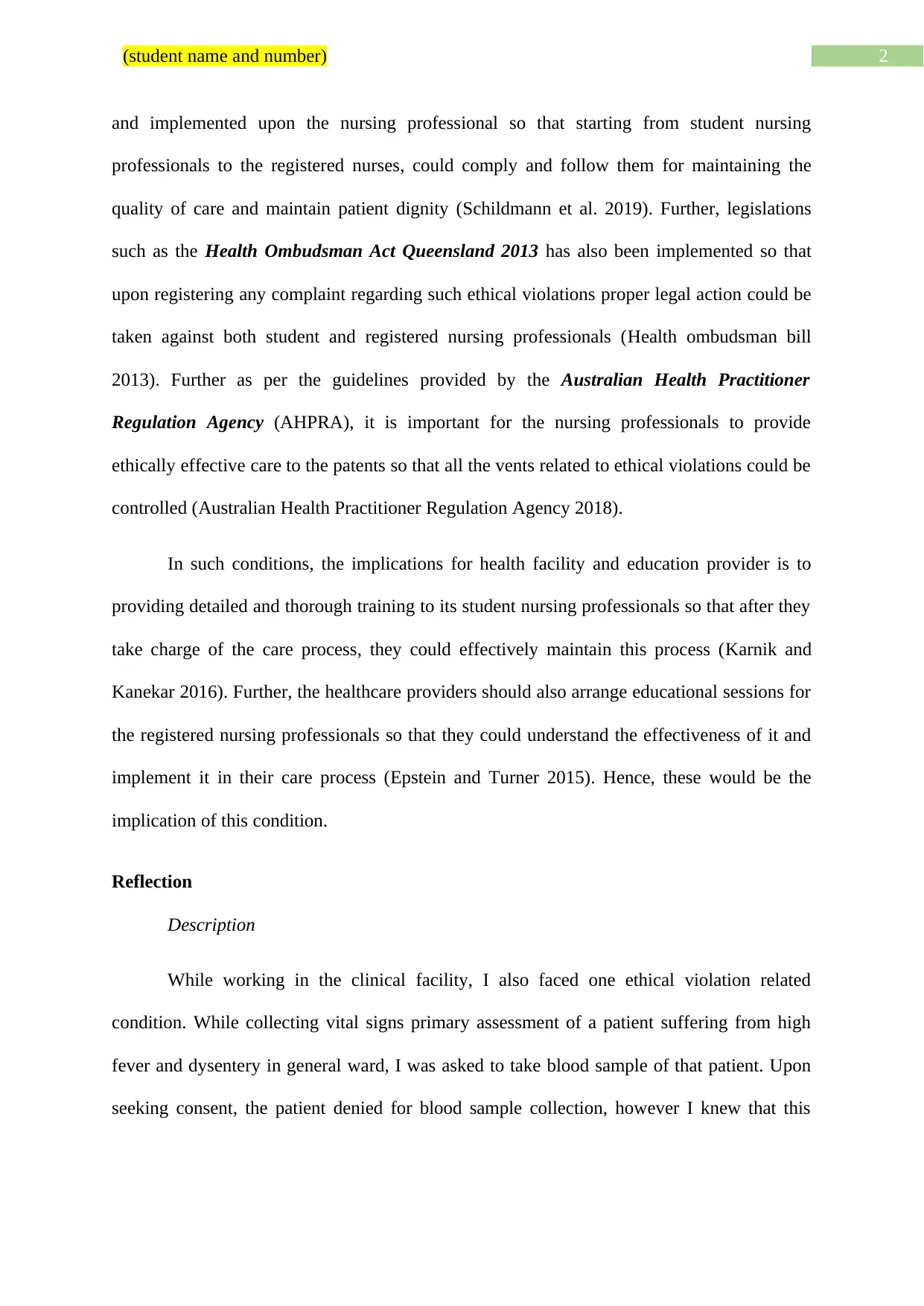
2(student name and number)
and implemented upon the nursing professional so that starting from student nursing
professionals to the registered nurses, could comply and follow them for maintaining the
quality of care and maintain patient dignity (Schildmann et al. 2019). Further, legislations
such as the Health Ombudsman Act Queensland 2013 has also been implemented so that
upon registering any complaint regarding such ethical violations proper legal action could be
taken against both student and registered nursing professionals (Health ombudsman bill
2013). Further as per the guidelines provided by the Australian Health Practitioner
Regulation Agency (AHPRA), it is important for the nursing professionals to provide
ethically effective care to the patents so that all the vents related to ethical violations could be
controlled (Australian Health Practitioner Regulation Agency 2018).
In such conditions, the implications for health facility and education provider is to
providing detailed and thorough training to its student nursing professionals so that after they
take charge of the care process, they could effectively maintain this process (Karnik and
Kanekar 2016). Further, the healthcare providers should also arrange educational sessions for
the registered nursing professionals so that they could understand the effectiveness of it and
implement it in their care process (Epstein and Turner 2015). Hence, these would be the
implication of this condition.
Reflection
Description
While working in the clinical facility, I also faced one ethical violation related
condition. While collecting vital signs primary assessment of a patient suffering from high
fever and dysentery in general ward, I was asked to take blood sample of that patient. Upon
seeking consent, the patient denied for blood sample collection, however I knew that this
and implemented upon the nursing professional so that starting from student nursing
professionals to the registered nurses, could comply and follow them for maintaining the
quality of care and maintain patient dignity (Schildmann et al. 2019). Further, legislations
such as the Health Ombudsman Act Queensland 2013 has also been implemented so that
upon registering any complaint regarding such ethical violations proper legal action could be
taken against both student and registered nursing professionals (Health ombudsman bill
2013). Further as per the guidelines provided by the Australian Health Practitioner
Regulation Agency (AHPRA), it is important for the nursing professionals to provide
ethically effective care to the patents so that all the vents related to ethical violations could be
controlled (Australian Health Practitioner Regulation Agency 2018).
In such conditions, the implications for health facility and education provider is to
providing detailed and thorough training to its student nursing professionals so that after they
take charge of the care process, they could effectively maintain this process (Karnik and
Kanekar 2016). Further, the healthcare providers should also arrange educational sessions for
the registered nursing professionals so that they could understand the effectiveness of it and
implement it in their care process (Epstein and Turner 2015). Hence, these would be the
implication of this condition.
Reflection
Description
While working in the clinical facility, I also faced one ethical violation related
condition. While collecting vital signs primary assessment of a patient suffering from high
fever and dysentery in general ward, I was asked to take blood sample of that patient. Upon
seeking consent, the patient denied for blood sample collection, however I knew that this
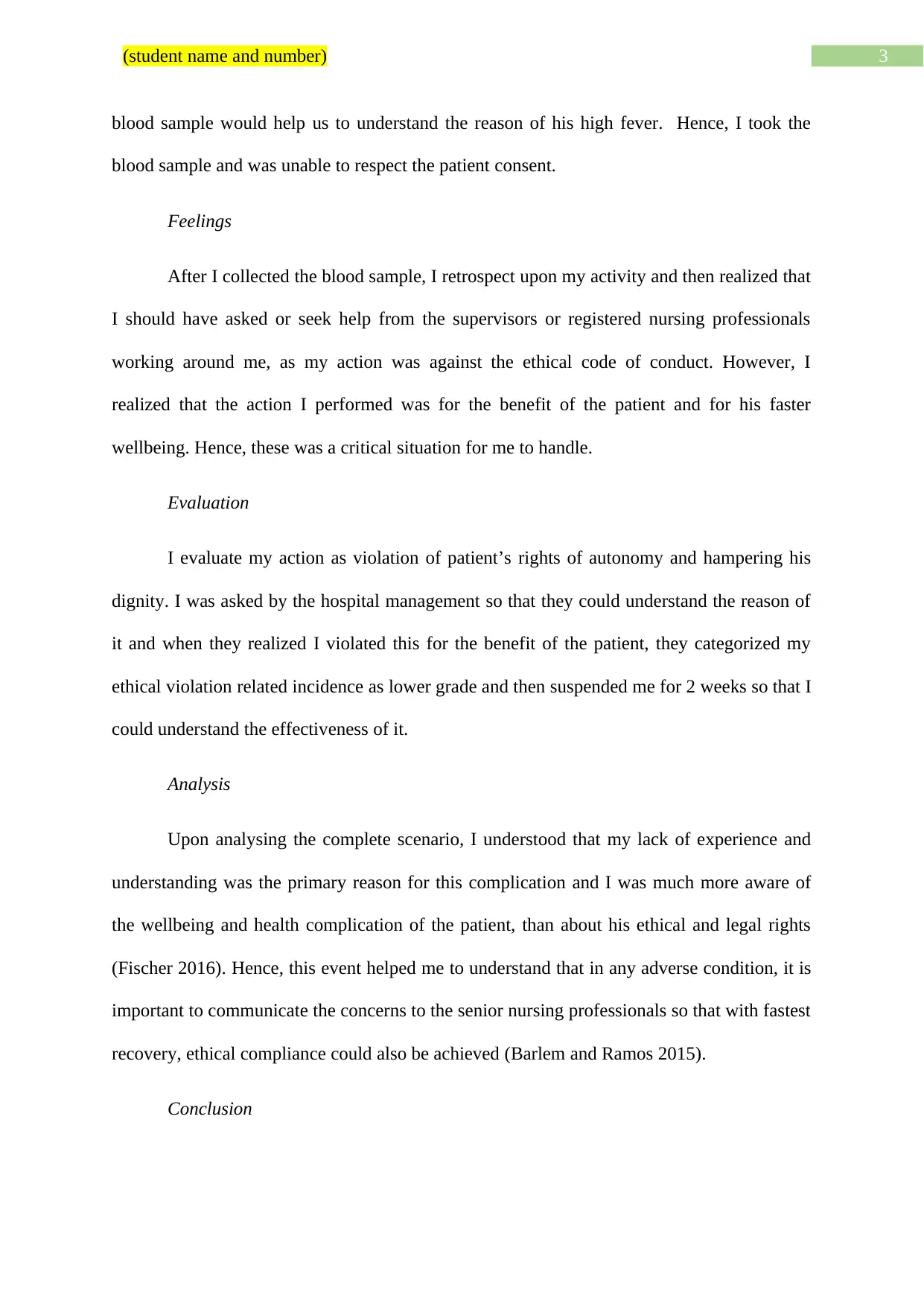
3(student name and number)
blood sample would help us to understand the reason of his high fever. Hence, I took the
blood sample and was unable to respect the patient consent.
Feelings
After I collected the blood sample, I retrospect upon my activity and then realized that
I should have asked or seek help from the supervisors or registered nursing professionals
working around me, as my action was against the ethical code of conduct. However, I
realized that the action I performed was for the benefit of the patient and for his faster
wellbeing. Hence, these was a critical situation for me to handle.
Evaluation
I evaluate my action as violation of patient’s rights of autonomy and hampering his
dignity. I was asked by the hospital management so that they could understand the reason of
it and when they realized I violated this for the benefit of the patient, they categorized my
ethical violation related incidence as lower grade and then suspended me for 2 weeks so that I
could understand the effectiveness of it.
Analysis
Upon analysing the complete scenario, I understood that my lack of experience and
understanding was the primary reason for this complication and I was much more aware of
the wellbeing and health complication of the patient, than about his ethical and legal rights
(Fischer 2016). Hence, this event helped me to understand that in any adverse condition, it is
important to communicate the concerns to the senior nursing professionals so that with fastest
recovery, ethical compliance could also be achieved (Barlem and Ramos 2015).
Conclusion
blood sample would help us to understand the reason of his high fever. Hence, I took the
blood sample and was unable to respect the patient consent.
Feelings
After I collected the blood sample, I retrospect upon my activity and then realized that
I should have asked or seek help from the supervisors or registered nursing professionals
working around me, as my action was against the ethical code of conduct. However, I
realized that the action I performed was for the benefit of the patient and for his faster
wellbeing. Hence, these was a critical situation for me to handle.
Evaluation
I evaluate my action as violation of patient’s rights of autonomy and hampering his
dignity. I was asked by the hospital management so that they could understand the reason of
it and when they realized I violated this for the benefit of the patient, they categorized my
ethical violation related incidence as lower grade and then suspended me for 2 weeks so that I
could understand the effectiveness of it.
Analysis
Upon analysing the complete scenario, I understood that my lack of experience and
understanding was the primary reason for this complication and I was much more aware of
the wellbeing and health complication of the patient, than about his ethical and legal rights
(Fischer 2016). Hence, this event helped me to understand that in any adverse condition, it is
important to communicate the concerns to the senior nursing professionals so that with fastest
recovery, ethical compliance could also be achieved (Barlem and Ramos 2015).
Conclusion
Secure Best Marks with AI Grader
Need help grading? Try our AI Grader for instant feedback on your assignments.
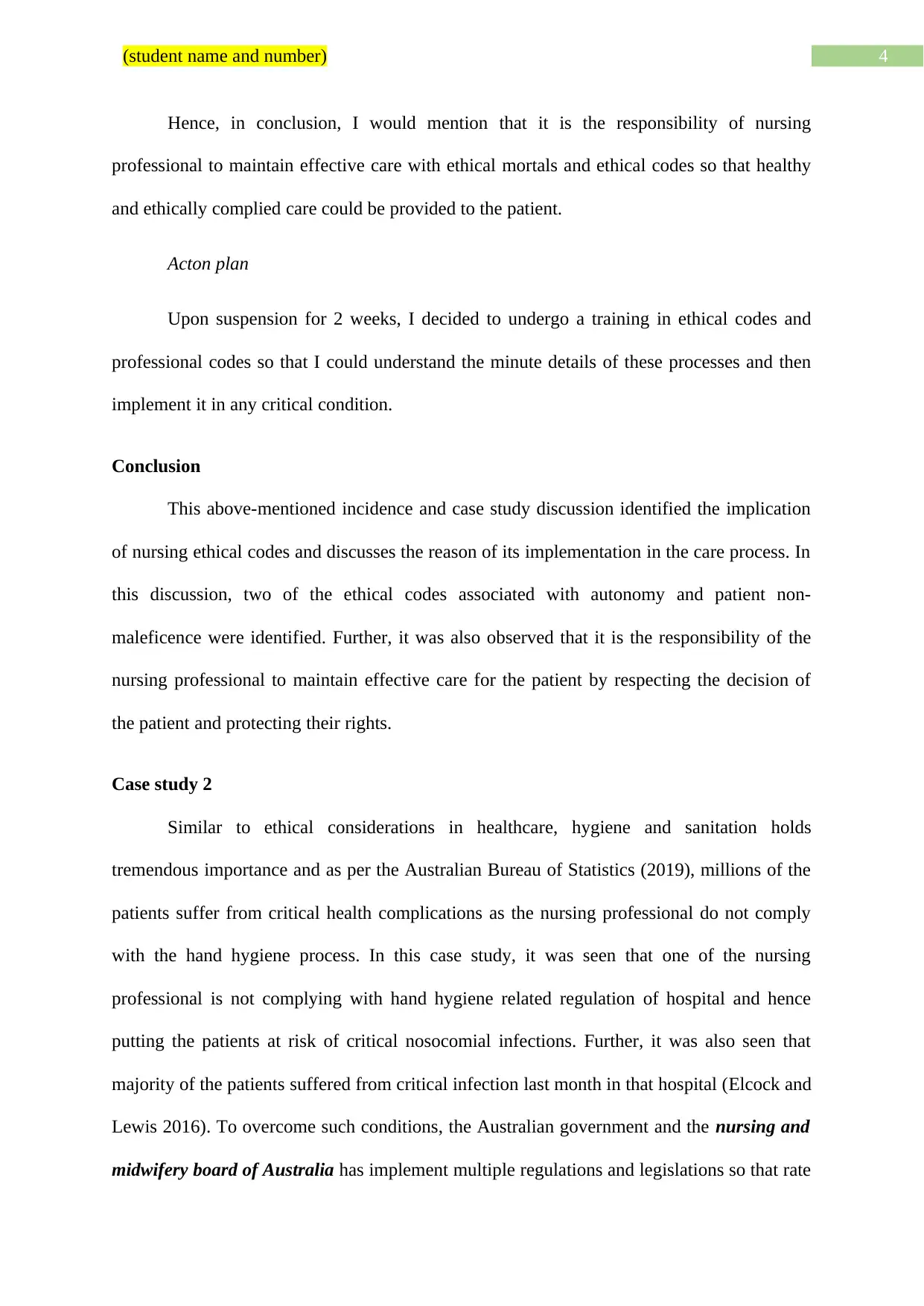
4(student name and number)
Hence, in conclusion, I would mention that it is the responsibility of nursing
professional to maintain effective care with ethical mortals and ethical codes so that healthy
and ethically complied care could be provided to the patient.
Acton plan
Upon suspension for 2 weeks, I decided to undergo a training in ethical codes and
professional codes so that I could understand the minute details of these processes and then
implement it in any critical condition.
Conclusion
This above-mentioned incidence and case study discussion identified the implication
of nursing ethical codes and discusses the reason of its implementation in the care process. In
this discussion, two of the ethical codes associated with autonomy and patient non-
maleficence were identified. Further, it was also observed that it is the responsibility of the
nursing professional to maintain effective care for the patient by respecting the decision of
the patient and protecting their rights.
Case study 2
Similar to ethical considerations in healthcare, hygiene and sanitation holds
tremendous importance and as per the Australian Bureau of Statistics (2019), millions of the
patients suffer from critical health complications as the nursing professional do not comply
with the hand hygiene process. In this case study, it was seen that one of the nursing
professional is not complying with hand hygiene related regulation of hospital and hence
putting the patients at risk of critical nosocomial infections. Further, it was also seen that
majority of the patients suffered from critical infection last month in that hospital (Elcock and
Lewis 2016). To overcome such conditions, the Australian government and the nursing and
midwifery board of Australia has implement multiple regulations and legislations so that rate
Hence, in conclusion, I would mention that it is the responsibility of nursing
professional to maintain effective care with ethical mortals and ethical codes so that healthy
and ethically complied care could be provided to the patient.
Acton plan
Upon suspension for 2 weeks, I decided to undergo a training in ethical codes and
professional codes so that I could understand the minute details of these processes and then
implement it in any critical condition.
Conclusion
This above-mentioned incidence and case study discussion identified the implication
of nursing ethical codes and discusses the reason of its implementation in the care process. In
this discussion, two of the ethical codes associated with autonomy and patient non-
maleficence were identified. Further, it was also observed that it is the responsibility of the
nursing professional to maintain effective care for the patient by respecting the decision of
the patient and protecting their rights.
Case study 2
Similar to ethical considerations in healthcare, hygiene and sanitation holds
tremendous importance and as per the Australian Bureau of Statistics (2019), millions of the
patients suffer from critical health complications as the nursing professional do not comply
with the hand hygiene process. In this case study, it was seen that one of the nursing
professional is not complying with hand hygiene related regulation of hospital and hence
putting the patients at risk of critical nosocomial infections. Further, it was also seen that
majority of the patients suffered from critical infection last month in that hospital (Elcock and
Lewis 2016). To overcome such conditions, the Australian government and the nursing and
midwifery board of Australia has implement multiple regulations and legislations so that rate
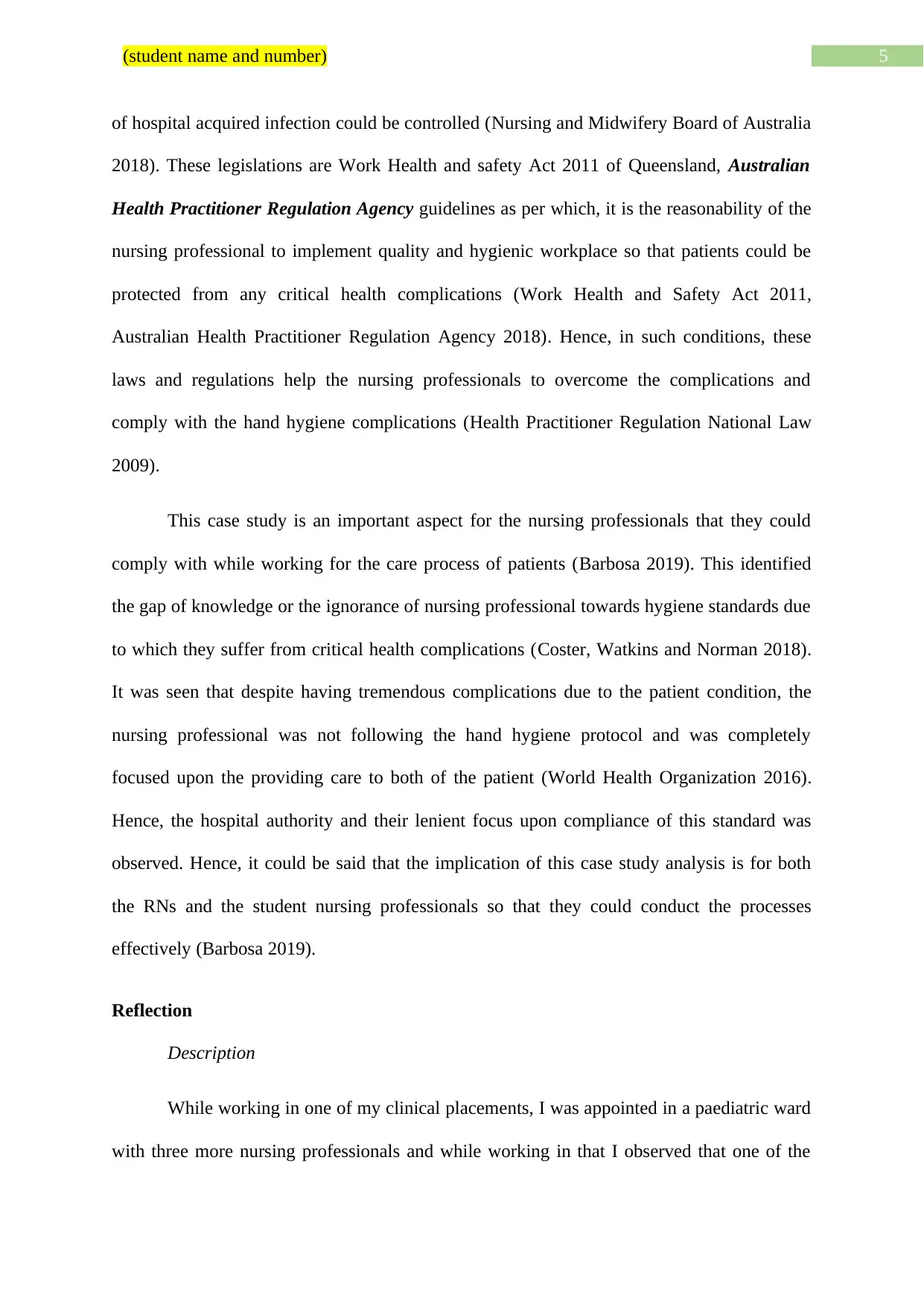
5(student name and number)
of hospital acquired infection could be controlled (Nursing and Midwifery Board of Australia
2018). These legislations are Work Health and safety Act 2011 of Queensland, Australian
Health Practitioner Regulation Agency guidelines as per which, it is the reasonability of the
nursing professional to implement quality and hygienic workplace so that patients could be
protected from any critical health complications (Work Health and Safety Act 2011,
Australian Health Practitioner Regulation Agency 2018). Hence, in such conditions, these
laws and regulations help the nursing professionals to overcome the complications and
comply with the hand hygiene complications (Health Practitioner Regulation National Law
2009).
This case study is an important aspect for the nursing professionals that they could
comply with while working for the care process of patients (Barbosa 2019). This identified
the gap of knowledge or the ignorance of nursing professional towards hygiene standards due
to which they suffer from critical health complications (Coster, Watkins and Norman 2018).
It was seen that despite having tremendous complications due to the patient condition, the
nursing professional was not following the hand hygiene protocol and was completely
focused upon the providing care to both of the patient (World Health Organization 2016).
Hence, the hospital authority and their lenient focus upon compliance of this standard was
observed. Hence, it could be said that the implication of this case study analysis is for both
the RNs and the student nursing professionals so that they could conduct the processes
effectively (Barbosa 2019).
Reflection
Description
While working in one of my clinical placements, I was appointed in a paediatric ward
with three more nursing professionals and while working in that I observed that one of the
of hospital acquired infection could be controlled (Nursing and Midwifery Board of Australia
2018). These legislations are Work Health and safety Act 2011 of Queensland, Australian
Health Practitioner Regulation Agency guidelines as per which, it is the reasonability of the
nursing professional to implement quality and hygienic workplace so that patients could be
protected from any critical health complications (Work Health and Safety Act 2011,
Australian Health Practitioner Regulation Agency 2018). Hence, in such conditions, these
laws and regulations help the nursing professionals to overcome the complications and
comply with the hand hygiene complications (Health Practitioner Regulation National Law
2009).
This case study is an important aspect for the nursing professionals that they could
comply with while working for the care process of patients (Barbosa 2019). This identified
the gap of knowledge or the ignorance of nursing professional towards hygiene standards due
to which they suffer from critical health complications (Coster, Watkins and Norman 2018).
It was seen that despite having tremendous complications due to the patient condition, the
nursing professional was not following the hand hygiene protocol and was completely
focused upon the providing care to both of the patient (World Health Organization 2016).
Hence, the hospital authority and their lenient focus upon compliance of this standard was
observed. Hence, it could be said that the implication of this case study analysis is for both
the RNs and the student nursing professionals so that they could conduct the processes
effectively (Barbosa 2019).
Reflection
Description
While working in one of my clinical placements, I was appointed in a paediatric ward
with three more nursing professionals and while working in that I observed that one of the
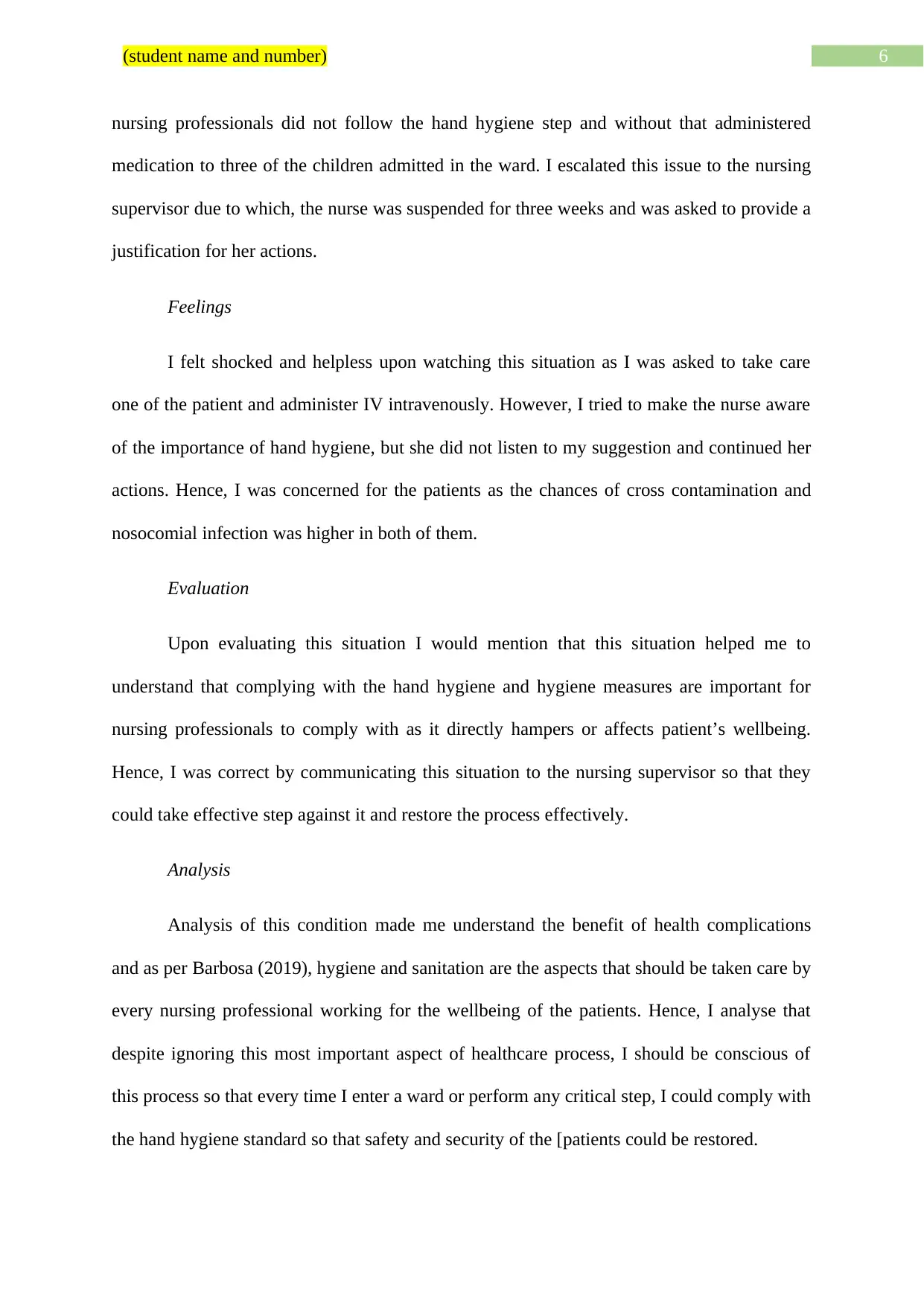
6(student name and number)
nursing professionals did not follow the hand hygiene step and without that administered
medication to three of the children admitted in the ward. I escalated this issue to the nursing
supervisor due to which, the nurse was suspended for three weeks and was asked to provide a
justification for her actions.
Feelings
I felt shocked and helpless upon watching this situation as I was asked to take care
one of the patient and administer IV intravenously. However, I tried to make the nurse aware
of the importance of hand hygiene, but she did not listen to my suggestion and continued her
actions. Hence, I was concerned for the patients as the chances of cross contamination and
nosocomial infection was higher in both of them.
Evaluation
Upon evaluating this situation I would mention that this situation helped me to
understand that complying with the hand hygiene and hygiene measures are important for
nursing professionals to comply with as it directly hampers or affects patient’s wellbeing.
Hence, I was correct by communicating this situation to the nursing supervisor so that they
could take effective step against it and restore the process effectively.
Analysis
Analysis of this condition made me understand the benefit of health complications
and as per Barbosa (2019), hygiene and sanitation are the aspects that should be taken care by
every nursing professional working for the wellbeing of the patients. Hence, I analyse that
despite ignoring this most important aspect of healthcare process, I should be conscious of
this process so that every time I enter a ward or perform any critical step, I could comply with
the hand hygiene standard so that safety and security of the [patients could be restored.
nursing professionals did not follow the hand hygiene step and without that administered
medication to three of the children admitted in the ward. I escalated this issue to the nursing
supervisor due to which, the nurse was suspended for three weeks and was asked to provide a
justification for her actions.
Feelings
I felt shocked and helpless upon watching this situation as I was asked to take care
one of the patient and administer IV intravenously. However, I tried to make the nurse aware
of the importance of hand hygiene, but she did not listen to my suggestion and continued her
actions. Hence, I was concerned for the patients as the chances of cross contamination and
nosocomial infection was higher in both of them.
Evaluation
Upon evaluating this situation I would mention that this situation helped me to
understand that complying with the hand hygiene and hygiene measures are important for
nursing professionals to comply with as it directly hampers or affects patient’s wellbeing.
Hence, I was correct by communicating this situation to the nursing supervisor so that they
could take effective step against it and restore the process effectively.
Analysis
Analysis of this condition made me understand the benefit of health complications
and as per Barbosa (2019), hygiene and sanitation are the aspects that should be taken care by
every nursing professional working for the wellbeing of the patients. Hence, I analyse that
despite ignoring this most important aspect of healthcare process, I should be conscious of
this process so that every time I enter a ward or perform any critical step, I could comply with
the hand hygiene standard so that safety and security of the [patients could be restored.
Paraphrase This Document
Need a fresh take? Get an instant paraphrase of this document with our AI Paraphraser
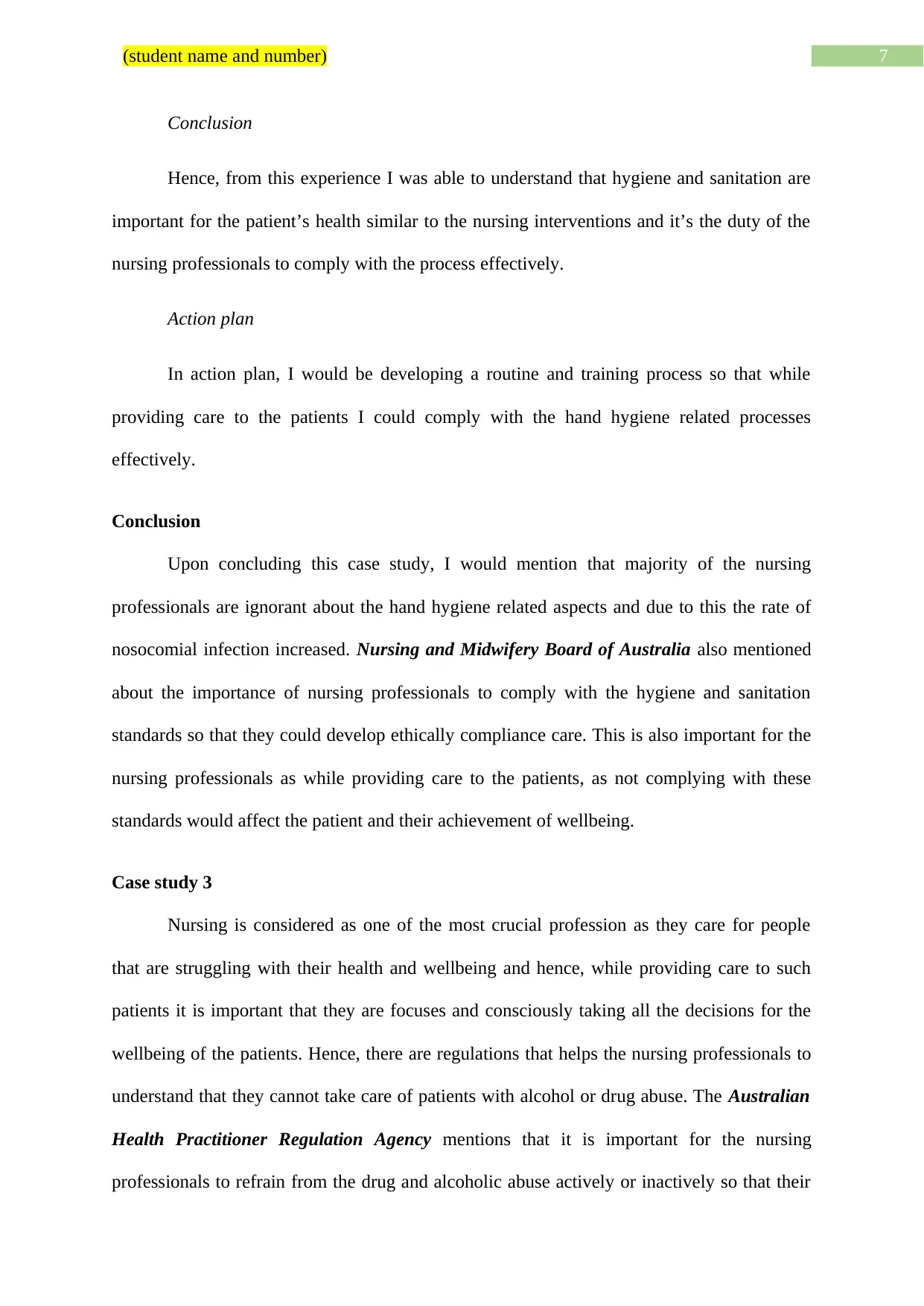
7(student name and number)
Conclusion
Hence, from this experience I was able to understand that hygiene and sanitation are
important for the patient’s health similar to the nursing interventions and it’s the duty of the
nursing professionals to comply with the process effectively.
Action plan
In action plan, I would be developing a routine and training process so that while
providing care to the patients I could comply with the hand hygiene related processes
effectively.
Conclusion
Upon concluding this case study, I would mention that majority of the nursing
professionals are ignorant about the hand hygiene related aspects and due to this the rate of
nosocomial infection increased. Nursing and Midwifery Board of Australia also mentioned
about the importance of nursing professionals to comply with the hygiene and sanitation
standards so that they could develop ethically compliance care. This is also important for the
nursing professionals as while providing care to the patients, as not complying with these
standards would affect the patient and their achievement of wellbeing.
Case study 3
Nursing is considered as one of the most crucial profession as they care for people
that are struggling with their health and wellbeing and hence, while providing care to such
patients it is important that they are focuses and consciously taking all the decisions for the
wellbeing of the patients. Hence, there are regulations that helps the nursing professionals to
understand that they cannot take care of patients with alcohol or drug abuse. The Australian
Health Practitioner Regulation Agency mentions that it is important for the nursing
professionals to refrain from the drug and alcoholic abuse actively or inactively so that their
Conclusion
Hence, from this experience I was able to understand that hygiene and sanitation are
important for the patient’s health similar to the nursing interventions and it’s the duty of the
nursing professionals to comply with the process effectively.
Action plan
In action plan, I would be developing a routine and training process so that while
providing care to the patients I could comply with the hand hygiene related processes
effectively.
Conclusion
Upon concluding this case study, I would mention that majority of the nursing
professionals are ignorant about the hand hygiene related aspects and due to this the rate of
nosocomial infection increased. Nursing and Midwifery Board of Australia also mentioned
about the importance of nursing professionals to comply with the hygiene and sanitation
standards so that they could develop ethically compliance care. This is also important for the
nursing professionals as while providing care to the patients, as not complying with these
standards would affect the patient and their achievement of wellbeing.
Case study 3
Nursing is considered as one of the most crucial profession as they care for people
that are struggling with their health and wellbeing and hence, while providing care to such
patients it is important that they are focuses and consciously taking all the decisions for the
wellbeing of the patients. Hence, there are regulations that helps the nursing professionals to
understand that they cannot take care of patients with alcohol or drug abuse. The Australian
Health Practitioner Regulation Agency mentions that it is important for the nursing
professionals to refrain from the drug and alcoholic abuse actively or inactively so that their
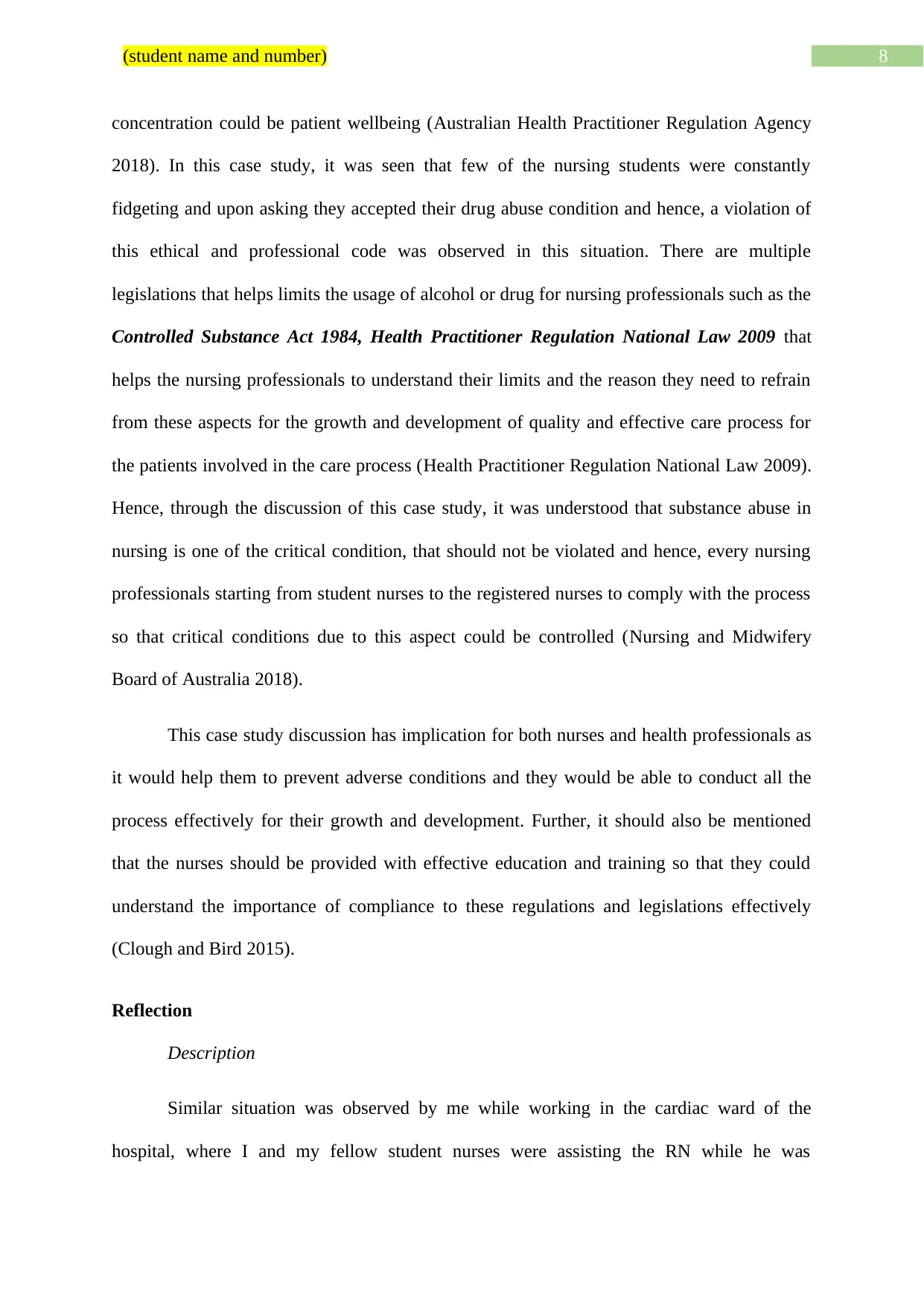
8(student name and number)
concentration could be patient wellbeing (Australian Health Practitioner Regulation Agency
2018). In this case study, it was seen that few of the nursing students were constantly
fidgeting and upon asking they accepted their drug abuse condition and hence, a violation of
this ethical and professional code was observed in this situation. There are multiple
legislations that helps limits the usage of alcohol or drug for nursing professionals such as the
Controlled Substance Act 1984, Health Practitioner Regulation National Law 2009 that
helps the nursing professionals to understand their limits and the reason they need to refrain
from these aspects for the growth and development of quality and effective care process for
the patients involved in the care process (Health Practitioner Regulation National Law 2009).
Hence, through the discussion of this case study, it was understood that substance abuse in
nursing is one of the critical condition, that should not be violated and hence, every nursing
professionals starting from student nurses to the registered nurses to comply with the process
so that critical conditions due to this aspect could be controlled (Nursing and Midwifery
Board of Australia 2018).
This case study discussion has implication for both nurses and health professionals as
it would help them to prevent adverse conditions and they would be able to conduct all the
process effectively for their growth and development. Further, it should also be mentioned
that the nurses should be provided with effective education and training so that they could
understand the importance of compliance to these regulations and legislations effectively
(Clough and Bird 2015).
Reflection
Description
Similar situation was observed by me while working in the cardiac ward of the
hospital, where I and my fellow student nurses were assisting the RN while he was
concentration could be patient wellbeing (Australian Health Practitioner Regulation Agency
2018). In this case study, it was seen that few of the nursing students were constantly
fidgeting and upon asking they accepted their drug abuse condition and hence, a violation of
this ethical and professional code was observed in this situation. There are multiple
legislations that helps limits the usage of alcohol or drug for nursing professionals such as the
Controlled Substance Act 1984, Health Practitioner Regulation National Law 2009 that
helps the nursing professionals to understand their limits and the reason they need to refrain
from these aspects for the growth and development of quality and effective care process for
the patients involved in the care process (Health Practitioner Regulation National Law 2009).
Hence, through the discussion of this case study, it was understood that substance abuse in
nursing is one of the critical condition, that should not be violated and hence, every nursing
professionals starting from student nurses to the registered nurses to comply with the process
so that critical conditions due to this aspect could be controlled (Nursing and Midwifery
Board of Australia 2018).
This case study discussion has implication for both nurses and health professionals as
it would help them to prevent adverse conditions and they would be able to conduct all the
process effectively for their growth and development. Further, it should also be mentioned
that the nurses should be provided with effective education and training so that they could
understand the importance of compliance to these regulations and legislations effectively
(Clough and Bird 2015).
Reflection
Description
Similar situation was observed by me while working in the cardiac ward of the
hospital, where I and my fellow student nurses were assisting the RN while he was
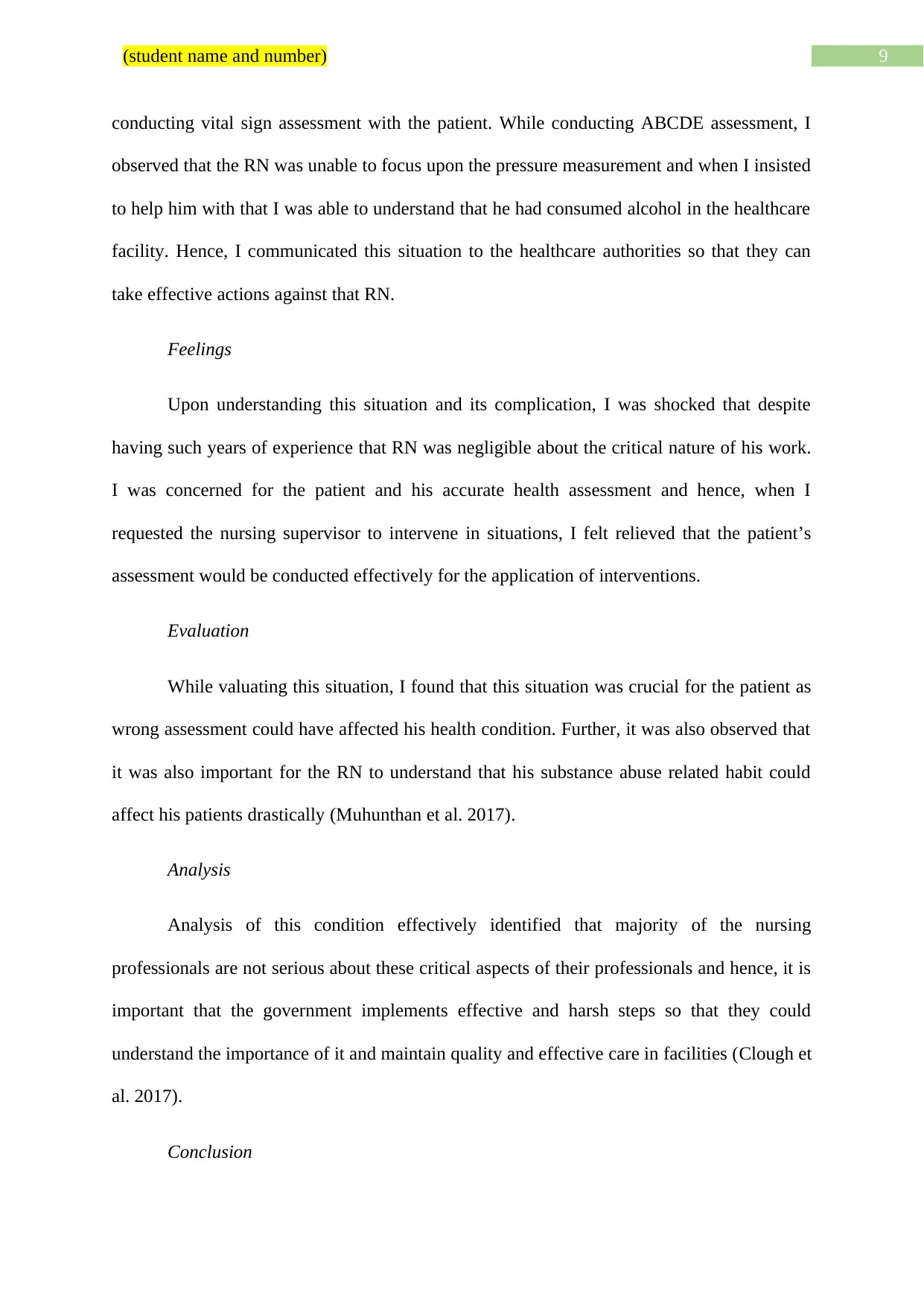
9(student name and number)
conducting vital sign assessment with the patient. While conducting ABCDE assessment, I
observed that the RN was unable to focus upon the pressure measurement and when I insisted
to help him with that I was able to understand that he had consumed alcohol in the healthcare
facility. Hence, I communicated this situation to the healthcare authorities so that they can
take effective actions against that RN.
Feelings
Upon understanding this situation and its complication, I was shocked that despite
having such years of experience that RN was negligible about the critical nature of his work.
I was concerned for the patient and his accurate health assessment and hence, when I
requested the nursing supervisor to intervene in situations, I felt relieved that the patient’s
assessment would be conducted effectively for the application of interventions.
Evaluation
While valuating this situation, I found that this situation was crucial for the patient as
wrong assessment could have affected his health condition. Further, it was also observed that
it was also important for the RN to understand that his substance abuse related habit could
affect his patients drastically (Muhunthan et al. 2017).
Analysis
Analysis of this condition effectively identified that majority of the nursing
professionals are not serious about these critical aspects of their professionals and hence, it is
important that the government implements effective and harsh steps so that they could
understand the importance of it and maintain quality and effective care in facilities (Clough et
al. 2017).
Conclusion
conducting vital sign assessment with the patient. While conducting ABCDE assessment, I
observed that the RN was unable to focus upon the pressure measurement and when I insisted
to help him with that I was able to understand that he had consumed alcohol in the healthcare
facility. Hence, I communicated this situation to the healthcare authorities so that they can
take effective actions against that RN.
Feelings
Upon understanding this situation and its complication, I was shocked that despite
having such years of experience that RN was negligible about the critical nature of his work.
I was concerned for the patient and his accurate health assessment and hence, when I
requested the nursing supervisor to intervene in situations, I felt relieved that the patient’s
assessment would be conducted effectively for the application of interventions.
Evaluation
While valuating this situation, I found that this situation was crucial for the patient as
wrong assessment could have affected his health condition. Further, it was also observed that
it was also important for the RN to understand that his substance abuse related habit could
affect his patients drastically (Muhunthan et al. 2017).
Analysis
Analysis of this condition effectively identified that majority of the nursing
professionals are not serious about these critical aspects of their professionals and hence, it is
important that the government implements effective and harsh steps so that they could
understand the importance of it and maintain quality and effective care in facilities (Clough et
al. 2017).
Conclusion
Secure Best Marks with AI Grader
Need help grading? Try our AI Grader for instant feedback on your assignments.
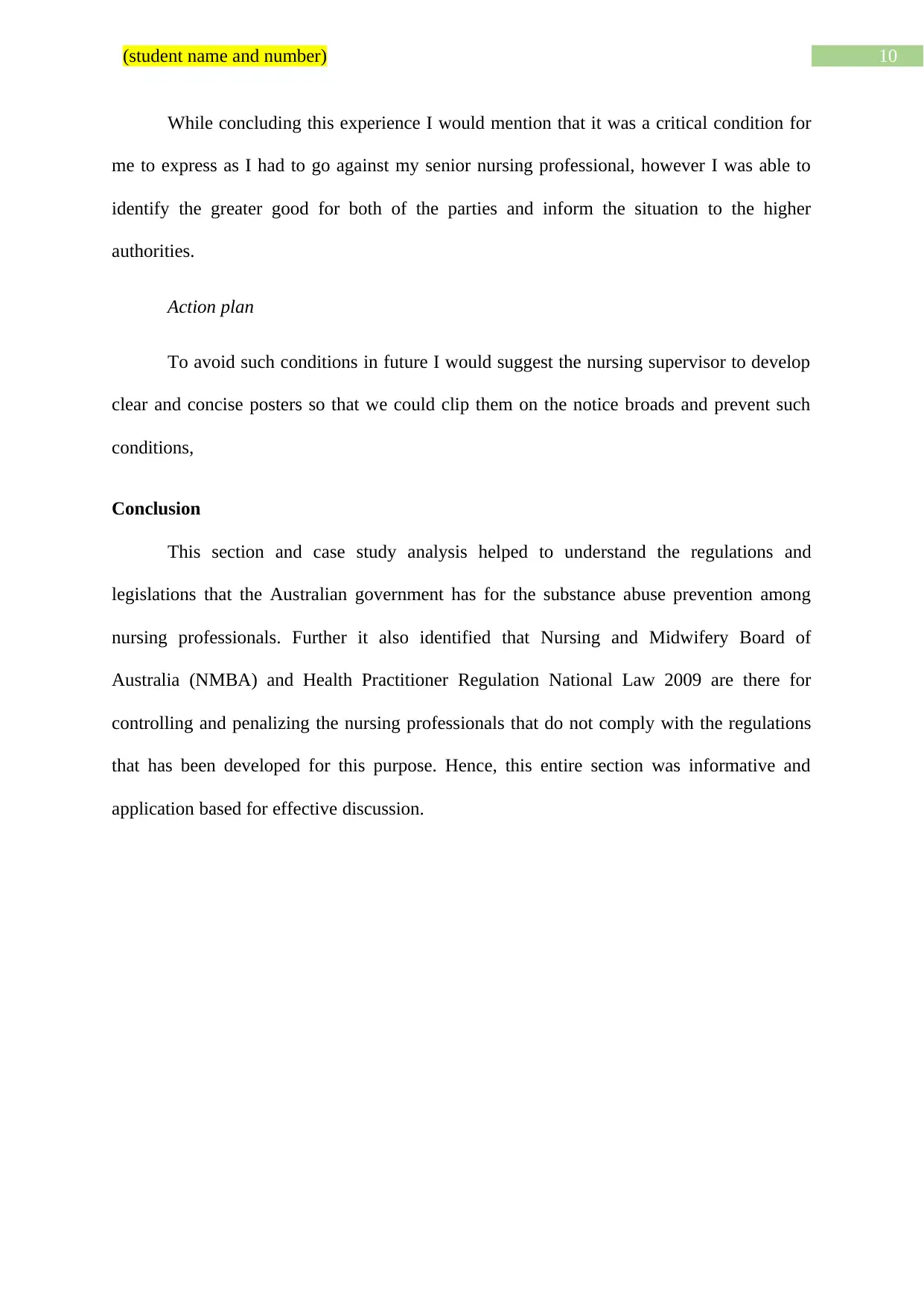
10(student name and number)
While concluding this experience I would mention that it was a critical condition for
me to express as I had to go against my senior nursing professional, however I was able to
identify the greater good for both of the parties and inform the situation to the higher
authorities.
Action plan
To avoid such conditions in future I would suggest the nursing supervisor to develop
clear and concise posters so that we could clip them on the notice broads and prevent such
conditions,
Conclusion
This section and case study analysis helped to understand the regulations and
legislations that the Australian government has for the substance abuse prevention among
nursing professionals. Further it also identified that Nursing and Midwifery Board of
Australia (NMBA) and Health Practitioner Regulation National Law 2009 are there for
controlling and penalizing the nursing professionals that do not comply with the regulations
that has been developed for this purpose. Hence, this entire section was informative and
application based for effective discussion.
While concluding this experience I would mention that it was a critical condition for
me to express as I had to go against my senior nursing professional, however I was able to
identify the greater good for both of the parties and inform the situation to the higher
authorities.
Action plan
To avoid such conditions in future I would suggest the nursing supervisor to develop
clear and concise posters so that we could clip them on the notice broads and prevent such
conditions,
Conclusion
This section and case study analysis helped to understand the regulations and
legislations that the Australian government has for the substance abuse prevention among
nursing professionals. Further it also identified that Nursing and Midwifery Board of
Australia (NMBA) and Health Practitioner Regulation National Law 2009 are there for
controlling and penalizing the nursing professionals that do not comply with the regulations
that has been developed for this purpose. Hence, this entire section was informative and
application based for effective discussion.
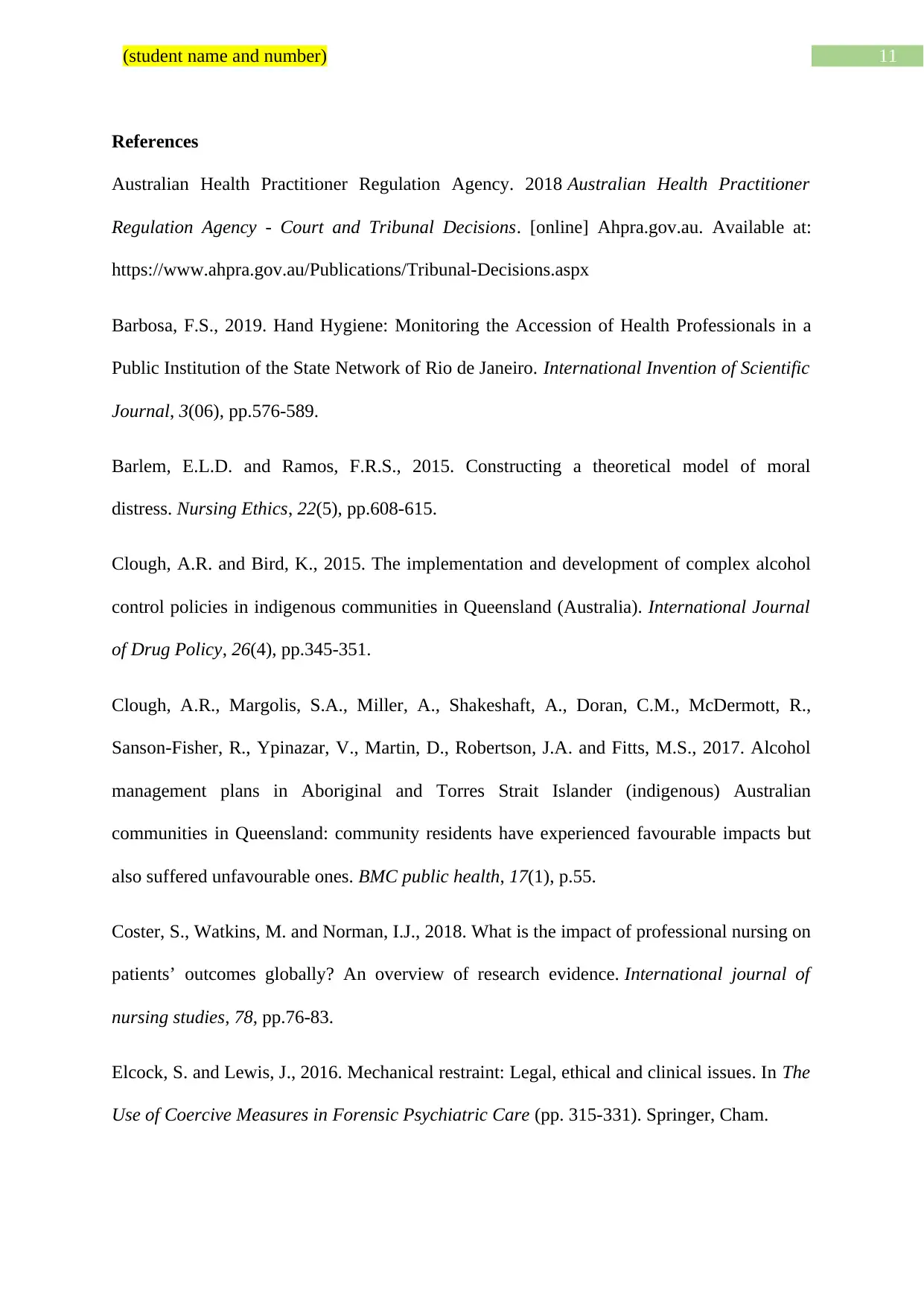
11(student name and number)
References
Australian Health Practitioner Regulation Agency. 2018 Australian Health Practitioner
Regulation Agency - Court and Tribunal Decisions. [online] Ahpra.gov.au. Available at:
https://www.ahpra.gov.au/Publications/Tribunal-Decisions.aspx
Barbosa, F.S., 2019. Hand Hygiene: Monitoring the Accession of Health Professionals in a
Public Institution of the State Network of Rio de Janeiro. International Invention of Scientific
Journal, 3(06), pp.576-589.
Barlem, E.L.D. and Ramos, F.R.S., 2015. Constructing a theoretical model of moral
distress. Nursing Ethics, 22(5), pp.608-615.
Clough, A.R. and Bird, K., 2015. The implementation and development of complex alcohol
control policies in indigenous communities in Queensland (Australia). International Journal
of Drug Policy, 26(4), pp.345-351.
Clough, A.R., Margolis, S.A., Miller, A., Shakeshaft, A., Doran, C.M., McDermott, R.,
Sanson-Fisher, R., Ypinazar, V., Martin, D., Robertson, J.A. and Fitts, M.S., 2017. Alcohol
management plans in Aboriginal and Torres Strait Islander (indigenous) Australian
communities in Queensland: community residents have experienced favourable impacts but
also suffered unfavourable ones. BMC public health, 17(1), p.55.
Coster, S., Watkins, M. and Norman, I.J., 2018. What is the impact of professional nursing on
patients’ outcomes globally? An overview of research evidence. International journal of
nursing studies, 78, pp.76-83.
Elcock, S. and Lewis, J., 2016. Mechanical restraint: Legal, ethical and clinical issues. In The
Use of Coercive Measures in Forensic Psychiatric Care (pp. 315-331). Springer, Cham.
References
Australian Health Practitioner Regulation Agency. 2018 Australian Health Practitioner
Regulation Agency - Court and Tribunal Decisions. [online] Ahpra.gov.au. Available at:
https://www.ahpra.gov.au/Publications/Tribunal-Decisions.aspx
Barbosa, F.S., 2019. Hand Hygiene: Monitoring the Accession of Health Professionals in a
Public Institution of the State Network of Rio de Janeiro. International Invention of Scientific
Journal, 3(06), pp.576-589.
Barlem, E.L.D. and Ramos, F.R.S., 2015. Constructing a theoretical model of moral
distress. Nursing Ethics, 22(5), pp.608-615.
Clough, A.R. and Bird, K., 2015. The implementation and development of complex alcohol
control policies in indigenous communities in Queensland (Australia). International Journal
of Drug Policy, 26(4), pp.345-351.
Clough, A.R., Margolis, S.A., Miller, A., Shakeshaft, A., Doran, C.M., McDermott, R.,
Sanson-Fisher, R., Ypinazar, V., Martin, D., Robertson, J.A. and Fitts, M.S., 2017. Alcohol
management plans in Aboriginal and Torres Strait Islander (indigenous) Australian
communities in Queensland: community residents have experienced favourable impacts but
also suffered unfavourable ones. BMC public health, 17(1), p.55.
Coster, S., Watkins, M. and Norman, I.J., 2018. What is the impact of professional nursing on
patients’ outcomes globally? An overview of research evidence. International journal of
nursing studies, 78, pp.76-83.
Elcock, S. and Lewis, J., 2016. Mechanical restraint: Legal, ethical and clinical issues. In The
Use of Coercive Measures in Forensic Psychiatric Care (pp. 315-331). Springer, Cham.
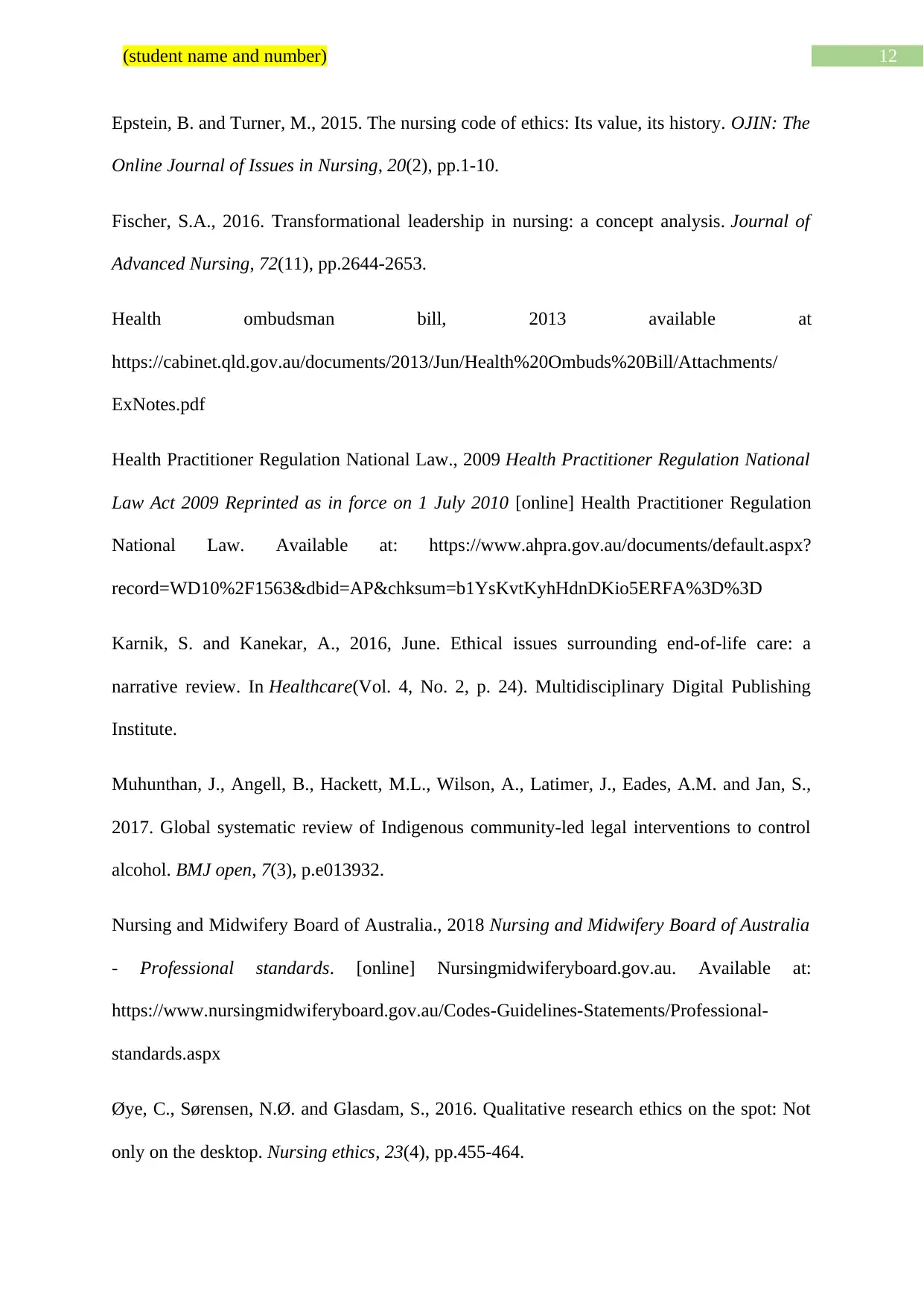
12(student name and number)
Epstein, B. and Turner, M., 2015. The nursing code of ethics: Its value, its history. OJIN: The
Online Journal of Issues in Nursing, 20(2), pp.1-10.
Fischer, S.A., 2016. Transformational leadership in nursing: a concept analysis. Journal of
Advanced Nursing, 72(11), pp.2644-2653.
Health ombudsman bill, 2013 available at
https://cabinet.qld.gov.au/documents/2013/Jun/Health%20Ombuds%20Bill/Attachments/
ExNotes.pdf
Health Practitioner Regulation National Law., 2009 Health Practitioner Regulation National
Law Act 2009 Reprinted as in force on 1 July 2010 [online] Health Practitioner Regulation
National Law. Available at: https://www.ahpra.gov.au/documents/default.aspx?
record=WD10%2F1563&dbid=AP&chksum=b1YsKvtKyhHdnDKio5ERFA%3D%3D
Karnik, S. and Kanekar, A., 2016, June. Ethical issues surrounding end-of-life care: a
narrative review. In Healthcare(Vol. 4, No. 2, p. 24). Multidisciplinary Digital Publishing
Institute.
Muhunthan, J., Angell, B., Hackett, M.L., Wilson, A., Latimer, J., Eades, A.M. and Jan, S.,
2017. Global systematic review of Indigenous community-led legal interventions to control
alcohol. BMJ open, 7(3), p.e013932.
Nursing and Midwifery Board of Australia., 2018 Nursing and Midwifery Board of Australia
- Professional standards. [online] Nursingmidwiferyboard.gov.au. Available at:
https://www.nursingmidwiferyboard.gov.au/Codes-Guidelines-Statements/Professional-
standards.aspx
Øye, C., Sørensen, N.Ø. and Glasdam, S., 2016. Qualitative research ethics on the spot: Not
only on the desktop. Nursing ethics, 23(4), pp.455-464.
Epstein, B. and Turner, M., 2015. The nursing code of ethics: Its value, its history. OJIN: The
Online Journal of Issues in Nursing, 20(2), pp.1-10.
Fischer, S.A., 2016. Transformational leadership in nursing: a concept analysis. Journal of
Advanced Nursing, 72(11), pp.2644-2653.
Health ombudsman bill, 2013 available at
https://cabinet.qld.gov.au/documents/2013/Jun/Health%20Ombuds%20Bill/Attachments/
ExNotes.pdf
Health Practitioner Regulation National Law., 2009 Health Practitioner Regulation National
Law Act 2009 Reprinted as in force on 1 July 2010 [online] Health Practitioner Regulation
National Law. Available at: https://www.ahpra.gov.au/documents/default.aspx?
record=WD10%2F1563&dbid=AP&chksum=b1YsKvtKyhHdnDKio5ERFA%3D%3D
Karnik, S. and Kanekar, A., 2016, June. Ethical issues surrounding end-of-life care: a
narrative review. In Healthcare(Vol. 4, No. 2, p. 24). Multidisciplinary Digital Publishing
Institute.
Muhunthan, J., Angell, B., Hackett, M.L., Wilson, A., Latimer, J., Eades, A.M. and Jan, S.,
2017. Global systematic review of Indigenous community-led legal interventions to control
alcohol. BMJ open, 7(3), p.e013932.
Nursing and Midwifery Board of Australia., 2018 Nursing and Midwifery Board of Australia
- Professional standards. [online] Nursingmidwiferyboard.gov.au. Available at:
https://www.nursingmidwiferyboard.gov.au/Codes-Guidelines-Statements/Professional-
standards.aspx
Øye, C., Sørensen, N.Ø. and Glasdam, S., 2016. Qualitative research ethics on the spot: Not
only on the desktop. Nursing ethics, 23(4), pp.455-464.
Paraphrase This Document
Need a fresh take? Get an instant paraphrase of this document with our AI Paraphraser
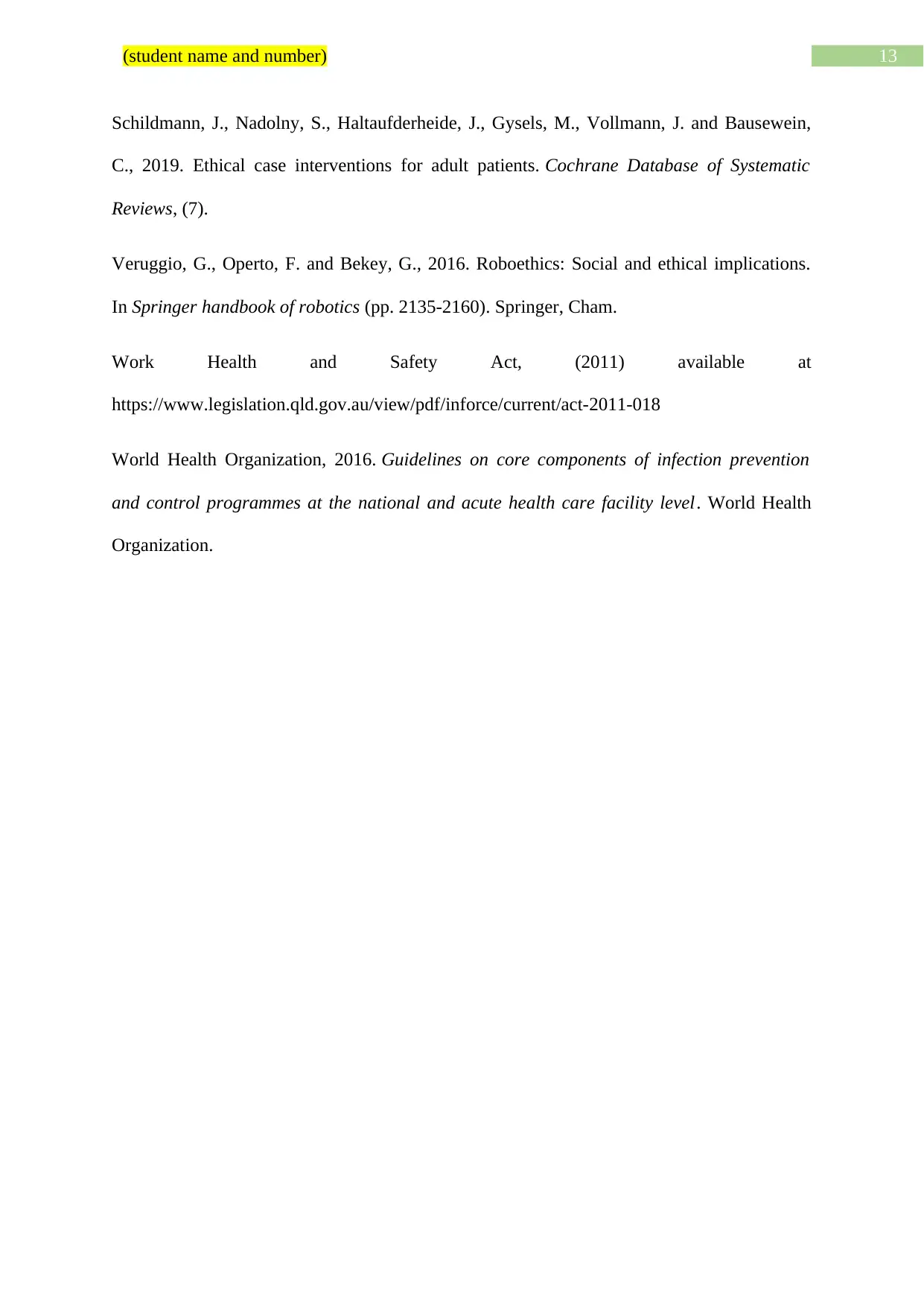
13(student name and number)
Schildmann, J., Nadolny, S., Haltaufderheide, J., Gysels, M., Vollmann, J. and Bausewein,
C., 2019. Ethical case interventions for adult patients. Cochrane Database of Systematic
Reviews, (7).
Veruggio, G., Operto, F. and Bekey, G., 2016. Roboethics: Social and ethical implications.
In Springer handbook of robotics (pp. 2135-2160). Springer, Cham.
Work Health and Safety Act, (2011) available at
https://www.legislation.qld.gov.au/view/pdf/inforce/current/act-2011-018
World Health Organization, 2016. Guidelines on core components of infection prevention
and control programmes at the national and acute health care facility level. World Health
Organization.
Schildmann, J., Nadolny, S., Haltaufderheide, J., Gysels, M., Vollmann, J. and Bausewein,
C., 2019. Ethical case interventions for adult patients. Cochrane Database of Systematic
Reviews, (7).
Veruggio, G., Operto, F. and Bekey, G., 2016. Roboethics: Social and ethical implications.
In Springer handbook of robotics (pp. 2135-2160). Springer, Cham.
Work Health and Safety Act, (2011) available at
https://www.legislation.qld.gov.au/view/pdf/inforce/current/act-2011-018
World Health Organization, 2016. Guidelines on core components of infection prevention
and control programmes at the national and acute health care facility level. World Health
Organization.
1 out of 14
Related Documents
Your All-in-One AI-Powered Toolkit for Academic Success.
+13062052269
info@desklib.com
Available 24*7 on WhatsApp / Email
![[object Object]](/_next/static/media/star-bottom.7253800d.svg)
Unlock your academic potential
© 2024 | Zucol Services PVT LTD | All rights reserved.




